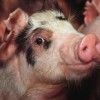 For the past six years, feed costs have continually increased and Florida has greater feed costs than the rest of the country because grain must be shipped here from where it was produced. But the Florida pork producers generally get prices above market value for their pigs because of strong demand for locally-raised foods. These Florida pork producers could become more profitable if they could significantly decrease their production costs. In Florida, pork producers have an opportunity to use citrus byproducts as a feedstuff to substantially and sustainably decrease their feed costs. This 4-page fact sheet was written by J. D. Crosswhite, N. B. Myers, A. T. Adesogan, J. H. Brendemuhl, D. D. Johnson, and C. C. Carr, and published by the UF Department of Animal Sciences, August 2012.
For the past six years, feed costs have continually increased and Florida has greater feed costs than the rest of the country because grain must be shipped here from where it was produced. But the Florida pork producers generally get prices above market value for their pigs because of strong demand for locally-raised foods. These Florida pork producers could become more profitable if they could significantly decrease their production costs. In Florida, pork producers have an opportunity to use citrus byproducts as a feedstuff to substantially and sustainably decrease their feed costs. This 4-page fact sheet was written by J. D. Crosswhite, N. B. Myers, A. T. Adesogan, J. H. Brendemuhl, D. D. Johnson, and C. C. Carr, and published by the UF Department of Animal Sciences, August 2012.
http://edis.ifas.ufl.edu/an282
Tag: D. D. Johnson
Ultrasound and Carcass Merit of Youth Market Cattle (AN279)
 Market cattle shown at county and state fairs and other youth shows across the United States are food animals. The endpoint value of food animals is primarily based on their carcass merit. Ideally, carcass merit should be assessed from actual carcasses. However, when carcass data cannot be collected, ultrasound evaluation of market cattle is an excellent method to accurately assess differences in fat thickness, ribeye area, and percentage of intramuscular fat within the ribeye. This 7-page fact sheet was written by Chad Carr, Dwain Johnson, and Mark Shuffitt, and published by the UF Department of Animal Science, June 2012.
Market cattle shown at county and state fairs and other youth shows across the United States are food animals. The endpoint value of food animals is primarily based on their carcass merit. Ideally, carcass merit should be assessed from actual carcasses. However, when carcass data cannot be collected, ultrasound evaluation of market cattle is an excellent method to accurately assess differences in fat thickness, ribeye area, and percentage of intramuscular fat within the ribeye. This 7-page fact sheet was written by Chad Carr, Dwain Johnson, and Mark Shuffitt, and published by the UF Department of Animal Science, June 2012.
http://edis.ifas.ufl.edu/an279
AN252 Ultrasound and Carcass Merit of Youth Market Hogs
AN252, a 5-page illustrated fact sheet by Chad Carr, Dwain Johnson, and Mark Shuffitt, describes the process whereby ultrasound evaluation of the live animal can be used to predict fat thickness and loineye area to determine the carcass merit of youth market hogs. Includes references. Published by the UF Department of Animal Science, October 2010.
http://edis.ifas.ufl.edu/an252
AN202/AN202 The Effects of Freezing on the Processing Characteristics and Palatability Attributes of Fresh Pork Legs
AN202, a 5-page report by B. G. Sapp, D. D. Johnson, L. E. Eubanks, and J. H. Brendemuhl, presents the results of a study to ascertain if de-boning and vacuum packaging of fresh hams for frozen storage had any effect on the processing qualities and oxidative rancidity of the cured ham as compared to the traditional method of freezing and storing of fresh bone-in hams. Includes references. Published by the UF Department of Animal Science, May 2008.
http://edis.ifas.ufl.edu/AN202